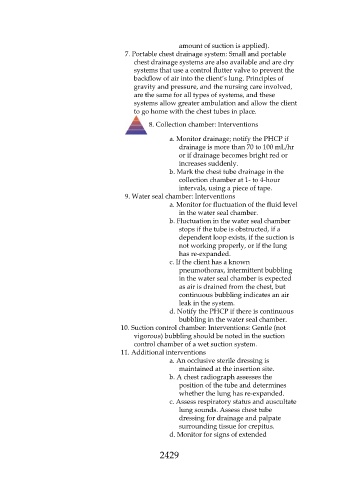Page 2429 - Saunders Comprehensive Review For NCLEX-RN
P. 2429
amount of suction is applied).
7. Portable chest drainage system: Small and portable
chest drainage systems are also available and are dry
systems that use a control flutter valve to prevent the
backflow of air into the client’s lung. Principles of
gravity and pressure, and the nursing care involved,
are the same for all types of systems, and these
systems allow greater ambulation and allow the client
to go home with the chest tubes in place.
8. Collection chamber: Interventions
a. Monitor drainage; notify the PHCP if
drainage is more than 70 to 100 mL/hr
or if drainage becomes bright red or
increases suddenly.
b. Mark the chest tube drainage in the
collection chamber at 1- to 4-hour
intervals, using a piece of tape.
9. Water seal chamber: Interventions
a. Monitor for fluctuation of the fluid level
in the water seal chamber.
b. Fluctuation in the water seal chamber
stops if the tube is obstructed, if a
dependent loop exists, if the suction is
not working properly, or if the lung
has re-expanded.
c. If the client has a known
pneumothorax, intermittent bubbling
in the water seal chamber is expected
as air is drained from the chest, but
continuous bubbling indicates an air
leak in the system.
d. Notify the PHCP if there is continuous
bubbling in the water seal chamber.
10. Suction control chamber: Interventions: Gentle (not
vigorous) bubbling should be noted in the suction
control chamber of a wet suction system.
11. Additional interventions
a. An occlusive sterile dressing is
maintained at the insertion site.
b. A chest radiograph assesses the
position of the tube and determines
whether the lung has re-expanded.
c. Assess respiratory status and auscultate
lung sounds. Assess chest tube
dressing for drainage and palpate
surrounding tissue for crepitus.
d. Monitor for signs of extended
2429

